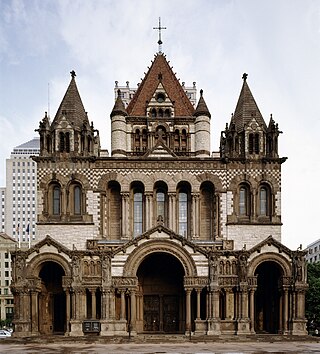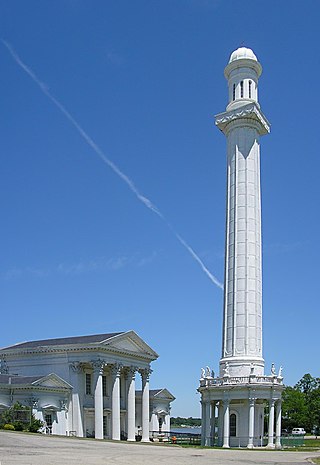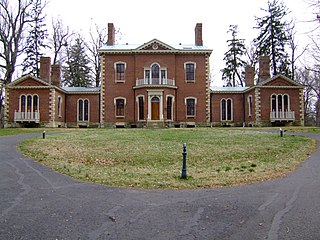Related Research Articles

Richardsonian Romanesque is a style of Romanesque Revival architecture named after the American architect Henry Hobson Richardson (1838–1886). The revival style incorporates 11th- and 12th-century southern French, Spanish, and Italian Romanesque characteristics. Richardson first used elements of the style in his Richardson Olmsted Complex in Buffalo, New York, designed in 1870, and Trinity Church in Boston is his most well-known example of this medieval revival style. Multiple architects followed in this style in the late 19th century; Richardsonian Romanesque later influenced modern styles of architecture as well.

Cannelton Cotton Mill, also known as Indiana Cotton Mill, is a National Historic Landmark of the United States located in Cannelton, Indiana, United States. Built in 1849 as an effort to expand textile milling out of New England, it was the largest industrial building west of the Allegheny Mountains, designed by Thomas Alexander Tefft, an early industrial architect. It was declared a National Historic Landmark in 1991. The building now houses residences.
Gideon Shryock was Kentucky's first professional architect in the Greek Revival Style. His name has frequently been misspelled as Gideon Shyrock.
Cincinnatus Shryock was an American architect. A number of his works are listed on the U.S. National Register of Historic Places.

The Louisville Water Tower, located east of downtown Louisville, Kentucky, near the riverfront, is the oldest ornamental water tower in the world, having been built before the more famous Chicago Water Tower. Both the actual water tower and its pumping station are a designated National Historic Landmark for their architecture. As with the Fairmount Water Works of Philadelphia, the industrial nature of its pumping station was disguised in the form of a Roman temple complex.
Samuel M. Plato (1882–1957) was an American architect and building contractor in the United States. His work includes federal housing projects and U.S. post offices, as well as private homes, banks, churches, and schools. During World War II, the Alabama native was one of the few African-American contractors in the country to be awarded wartime building contracts, which included Wake and Midway Halls. He also received contracts to build at least thirty-eight U.S. post offices across the country.

William Ellery Channing Whitney was an American architect who practiced in Minneapolis, Minnesota. He specialized primarily in domestic architecture, designing homes for many prominent Twin Cities families.

Brinton Beauregard Davis was an American architect in Kentucky. More than a dozen of his works are listed on the National Register of Historic Places.

Julius Carl "Jules" Leffland was a Danish-born architect known for his work in Victoria, Texas, and throughout South Texas. He was active in South Texas from approximately 1886 until the 1910s. Many of his works are listed on the National Register of Historic Places.

Joseph & Joseph is an architectural firm founded in 1908 in Louisville, Kentucky. The main services include architectural, engineering and design projects.

Thomas Lewinski was an architect in Kentucky, United States. Born in England, he immigrated to the United States. For his work at Allenhurst and elsewhere, Lewinski was known in his day as one of the leading architects of the Greek Revival style. He designed many architecturally significant buildings that survive and are listed on the United States National Register of Historic Places.
McDonald Brothers founded in 1878 was a Louisville-based firm of architects of courthouses and other public buildings. It was a partnership of brothers Kenneth McDonald, Harry McDonald, and Donald McDonald.

Bradlee, Winslow & Wetherell (1872–1888) was an architecture firm in Boston, Massachusetts. Its principals were Nathaniel Jeremiah Bradlee (1829–1888), Walter Thacher Winslow (1843–1909) and George Homans Wetherell (1854–1930). Most of the firm's work was local to Boston and New England, with a few commissions as far afield as Seattle and Kansas City.
Luckett & Farley is an architecture, engineering, and interior design firm based in Louisville, Kentucky. It was founded in 1853, making it the oldest continually operating architecture firm in the United States that is not a wholly owned subsidiary. The firm began under the name Rogers, Whitestone & Co., Architects, changing its name to Henry Whitestone in 1857, to D.X. Murphy & Brother in 1890, and to Luckett & Farley in 1962. The company is 100% employee-owned as of January 1, 2012 and concentrates on automotive, industrial, federal government, higher education, health and wellness, and corporate/commercial markets. There are more LEED professionals at Luckett & Farley than any other company in Kentucky with 50, as of December 2012.

Henry Whitestone (1819–1893) was an architect born in County Clare, Ireland who became one of the main architects of Louisville, Kentucky.

Montezuma Fuller (1858–1925) was an American architect. He was the "most notable architect in the late nineteenth and early twentieth centuries" of Fort Collins, Colorado.

James J. Gaffney, most often known as J. J. Gaffney, was an American architect in Louisville, Kentucky.

The Midlands is a private house in Indian Hills, Kentucky in suburban Louisville built 1913–1914; it is listed on the American National Register of Historic Places. It was built for Marion Dumont Belknap, who was the widow of Louisville businessman Morris B. Belknap, who had died in 1910. It was designed by the Louisville firm of E.T. Hutchings.

William Strudwick Arrasmith was an American architect known for his designs for Greyhound bus stations in the Streamline Moderne style popular in the 1930s and 1940s. Among the over 60 stations he designed are the Cleveland Greyhound Bus Station (1948), the Montgomery, Alabama, Greyhound Bus Station (1951), and the Evansville, Indiana, Greyhound Bus Terminal (1938) which are listed on the National Register of Historic Places.

Frederic L. Morgan was an American architect in practice in Louisville, Kentucky from 1921 until his death in 1970. Morgan spent nearly all of his career as partner responsible for design for Nevin & Morgan, the most successful architectural firm in Louisville during its existence.
References
- ↑ William Elsey Connelley, Ellis Merton Coulter (1922). History of Kentucky, Volume 3. American Historical Society. p. 164. ISBN 9780598572981.
- ↑ John E. Kleber (2000). The Encyclopedia of Louisville. University Press of Kentucky. p. 411. ISBN 0813121000.
- ↑ "E. T. Hutchings". American Institute of Architects. Archived from the original on 2013-02-23. Retrieved 2012-09-28.
- 1 2 3 4 5 6 7 8 9 "National Register Information System". National Register of Historic Places . National Park Service. July 9, 2010.
- ↑ Mary Jean Kinsman (1983). "Kentucky Historic Resources Inventory: The Midlands". National Park Service. and accompanying photos